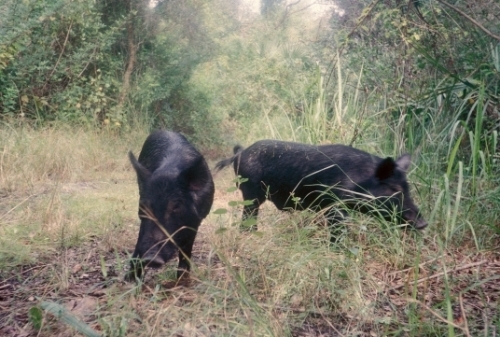Prevent feral swine overpopulation in Michigan
Be on the lookout for this nuisance species in Michigan’s fields and forests; action now prevents damage later.
 Spring is in full swing, prompting sightings of baby critters of all
kinds: chicks, fawns, foals, goslings, etc. There is a certain kind of animal,
however, that Michigan doesn’t need to see more of on the landscape: feral
swine. Feral swine in the state are usually a hybrid between Eurasian wild boar
and domestic swine. According to the Michigan Department of Natural Resources, these
animals have been seen in 72 of the state’s 83 counties as of last year.
Spring is in full swing, prompting sightings of baby critters of all
kinds: chicks, fawns, foals, goslings, etc. There is a certain kind of animal,
however, that Michigan doesn’t need to see more of on the landscape: feral
swine. Feral swine in the state are usually a hybrid between Eurasian wild boar
and domestic swine. According to the Michigan Department of Natural Resources, these
animals have been seen in 72 of the state’s 83 counties as of last year.
They have the potential to become much more numerous for a combination of biological and ecological reasons. Feral swine mature quickly, have litter sizes of five to six pups, and can raise two to three litters per year. They can and will eat almost anything from nuts, roots and seeds to ground-dwelling animals and carcasses. They also flourish in a variety of different habitats, from open flat fields to deep, wet wooded areas. This makes feral swine very adaptable as compared to other wildlife species that tend to have more specific requirements.
Even if they are fruitful and multiplying, why are feral swine considered to be a nuisance species? These animals have the potential to carry serious diseases and can damage fragile habitats. For example, these swine can carry pseudo rabies, which can be transmitted to domestic swine as well as any household pets that may come in contact with them.
Feral swine can also wreak havoc on farm fields and forests. By nature these swine are “grubbers” and their strong snouts can root into most soils in search of food, leaving deep ruts and clumps that leave tree and understory roots exposed. These damaged root systems can interfere with water uptake and introduce rot and other diseases that eventually kill the affected vegetation. Rooting also damages the herbaceous layer, destroying habitat for other ground-dwelling animals and putting more sensitive species in jeopardy. Rooting activity can also damage soils to the point where plant recovery is slow and difficult, placing additional stress on the ecosystem.
Feral swine also regularly create “wallows” in wet areas to reduce body temperatures and rid themselves of external parasites. This activity also damages soils and interferes with root systems, as well as greatly reducing water quality through soil erosion and animal waste. Swine also rub themselves against any standing trees near these wallows to work off any excess mud and skin parasites, further exposing the trees to structural damage and fungal/pathogen infections.
Despite many confirmed sightings of feral swine and the serious damage they can inflict, this nuisance species is not yet commonly seen in Michigan’s fields and forests. Some might ask the question: “If they’re not commonly seen yet, why worry about them?” In fact, this is the ideal time to “worry about them” and begin addressing the problem.
This invasive species, like most other plant and animal invasives, follows a general, three-stage pattern of spread: invasion, colonization and naturalization as explained by Roger Cousens and Martin Mortimer in “Dynamics of Weed Populations.” When a species first invades, it takes some time to become established. This “lag time” gives us the best opportunity to eradicate the invader, but it is hard to do because the new species isn’t easily found.
By the time the species is regularly seen, it has likely reached the colonization stage. At this point, the population is large enough for individuals to find mates and reproduce regularly. It will take a lot more time, effort and resources to control the invader at this colonization stage, and it is very unlikely that total eradication is possible. This means the battle against the species, and the economic and ecological damage it can cause, will continue long into the foreseeable future if swift and decisive steps are not taken now.
If this nuisance species is not controlled soon, Michigan may find itself in the same situation as some southern states like Mississippi or Texas, where increased hunting and trapping alone is no longer enough to control population growth in some regions (see “A Pickup Load of Pigs: The Feral Swine Pandemic” developed by Mississippi State University for more information).
This dangerous combination as potential disease carrier, landscape damager and prolific reproducer is why the Michigan Departments of Natural Resources and theMichigan Department of Agriculture and Rural Development have banned the possession of this type of swine since April 1, 2012.
What can you do? If you have a valid hunter’s license, you are allowed to shoot feral swine at any time. Additionally, private property owners who find them on their property are allowed to take them without a license. If you are not a hunter and feel you have seen these animals or signs of their damage, you are encouraged to contact Nate Newman at the USDA Wildlife Services Office in East Lansing at 517-336-1928.
Sightings, kills and damages can also be reported using this online form.



 Print
Print Email
Email

